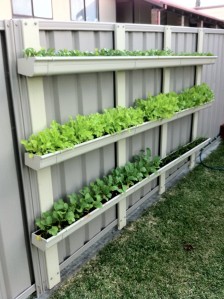My husband made this lame little clip on his phone and uploaded it onto YouTube only to be shocked by how many views it’s received. At this point over 8,318 people have spent 43 silent seconds of their lives to view my husband’s captivating work. What it has shown us though (besides the fact that we should quit our jobs, sell everything and get into the film industry) is that more and more people are looking for ways to garden and grow in small urban spaces. And gutter gardens are a great way of doing it.
1. Choose a good location on the fence. We chose a North-facing panel (we’re in Australia, if you’re in the Northern Hemisphere go South-facing) that was next to the deck (easy access) and that received lots of sun. Mind you, be aware that the Australian summer eats lettuce for breakfast, but it’s been a great garden for fall, winter and spring.
2. If you’re starting with a strong timber fence with strong vertical posts then get straight to it. We have a ColourBond so we reinforced the structure with some upright supports, you also need something to attach the gutters to. We just used left-over decking boards, so anything really will do. Just screw into the ColourBond on the top and bottom rail.
3. Source your gutter, brackets and end-caps. There’s a surprising amount of gutter shapes available so have a look around and choose the one that’s best for you. We went for a deep square-ish shape to hold the most soil.
4. If you’re painting, may I suggest doing that now. Afterwards is a pain in the butt.
5. Mount your gutters level along the fence, you don’t want all the water pooling in one end of the gutter. You’ll notice that our fence does not run level, but our garden beds do. It doesn’t look too bad.
6. Line the bottom of the gutters with old socks or other absorbent rags. This will really help to retain moisture is such shallow beds.
7. Fill the gutters with soil. Choose something GOOD QUALITY. You will undoubtedly be disappointed by what your average $4 bag of potting mix will produce. It’s always worth investing in good soil. It’s essentially what your plants eat and eventually what you’ll eat.
8. Plant veggies that don’t require a great deal of soil. We’ve had great success with all kinds of lettuce, radishes, baby bok choy, and even onions. I’ve heard gutters can work well for strawberries too.
9. Watch your crop grow! Make sure you water regularly, as they tend to dry out quickly on hot days.
NOTE: It’d be pretty easy to hook up a self-watering system if you’re really clever. All you’d need is enough length of self-watering hose (or you could get fancy if you have some old hose to recycle) from the local hardware or gardening centre. Self-timers are available as well if you want to get high-tech.
10. Eat a massive salad using the bounty from your hard work. 🙂



Leave a comment